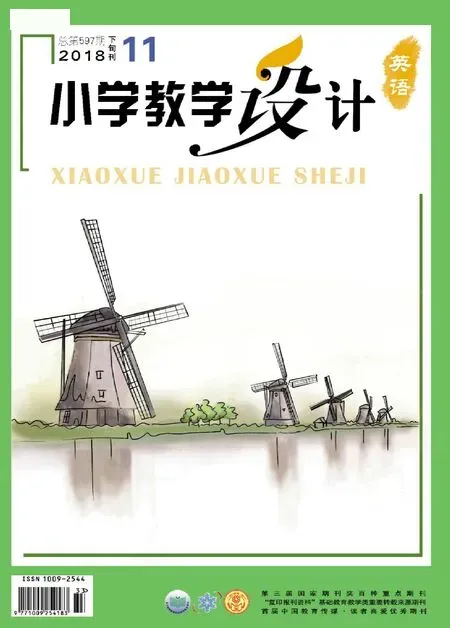巧用过渡语,优化英语语篇教学
——以修订版PEP五(上)Unit 4 What can you do?Read and write为例
魏延丰
在教学过程中,我们通常会创设相关情境来展开英语教学活动。不同的教学活动各环节之间我们通常又会用一定的过渡语来衔接,合理巧妙地过渡语言,能有效延伸教学情境,提示和引导学生顺利地转入下一个环节的学习,如穿针引线,把一节课的诸多环节衔接成一个连贯紧凑、浑然天成的有机整体,提升学生思维水平,提高课堂教学效果。下面以修订版PEP五(上)Unit 4 What can you do?Read and write一课为例,阐述如何巧用过渡语,优化英语语篇教学。
一、Pre-reading环节——串在旧知间,无痕巧铺垫
1.Greeting.
过渡语:Hello,children.I’m your new English teacher.This ismyEnglish name,can you read?课件呈现:You’re so clever.I’m Candice,I’m friendly.I want to make friends with you.Look!This is my email,I write it on the red heart card(.展示卡片说明本节课的奖励机制)If you did a good job,you can get it,then we can be friends.
2.Sharp eyes.
过渡语:Can you remember the phrases we learn in this unit? First,let’s play a game:sharp eyes.Look at the screen,see the phrasesasquickly as youcan.屏幕最后定格在“Listen, I can sing English songs”上,教师随机唱了一段学生喜闻乐见的“Do Re Mi”。
T:Whatcan you do?
S1:I can dance.
T:Can you dance for us?
3.Free talk.
过渡语:Now,children,it’s your turn. Ask and answer like this.
设计意图:Pre-reading环节,热身活动,通常也是复习活动,是一堂课的开始,它的有效程度直接决定了这节课的学习效果。教师通过Greeting,Sharp eyes和Free talk三个活动充分激活旧知,并用精心设计的过渡语引起学生的注意,让学生迅速进入学习英语的状态,为接下来的学习做好铺垫。
二、While-reading环节——串在新授间,无痕巧呈现
1.Skip reading.
过渡语:Children,you can do somanythings.Can you read this word(教师展示词卡,an email)? Look,here is an email from Robin.What’sthisemail about?(学生猜)Now,let’s read the passage quickly and choose the right answer.
2.Detailed reading.
过渡语: Robin wants a friend.If you want to make friendswith Robin,you should know more about him,yes?So,what can Robin do?Read and tick or cross now.
3.Deep reading.
过渡语: Now,we know Robin can do many things.Do you wanttoknow moreinformationsaboutRobin.Read for the third time and find the difficuties.
While-reading环节主要使用顺流式过渡语。Skip reading,Detailed reading,Deep reading三个环节运用了非常巧妙的过渡语来衔接,这一系列的过渡语弥补了从一个环节到另一个环节,跳跃性过渡的缺陷,使学生在不断的探究中不知不觉地进入了新的情境,实现了课堂教学环节转换的天衣无缝。
三、Post-reading环节——串在操练间,无痕巧拓展
1.Listen and repeat.
过渡语:After reading,we know more informations about Robin. Now let’s listen to Robin’s voice.承接上文,以听Robin的声音为由,自然过渡到听音模仿环节。
2.Retell the passage.
过渡语:Wow,there are so many Robots in our classroom.I like your voice very much.Robots,can you introduce yourself?引导学生利用板书复述文本:I’m...I can...I can’t... 由听录音跟读顺延到Retell the passage。
3.Introduce yourself.
过渡语:Robin can do many things. Do you want to be Robin’s friends. Now, write some sentences to introduce yourself. Who wants to be Robin’s friends?(一名学生展示)I think maybe Robin wants to make friends with you.
4.Story time.
过渡语:Listen!Robin is talking.播放声音文件:Wow,you’re helpful.I want to make friends with you.Now,let’s enjoy a story together.由Robin对学生自我介绍的反馈直接过渡到Story time的学习,自然、流畅,水到渠成。
板块的过渡往往会给一部分学生带来一种压迫感,他们会觉得这是教师的任务而不得不去做。Post-reading环节,随着学生的心愿,通过巧妙过渡,让学生从语言知识的操练阶段自然过渡到初步运用阶段,引领他们在创造中尝试着运用语言。
过渡语是小学英语教学活动各个环节的纽带,也是各个环节的润滑剂,是完整课堂结构中不可或缺的组成部分。因为有了过渡语的起承转合,才有了灵动升级的课堂。教师有效地使用过渡语,可以为学生的课堂学习牵线搭桥,使他们在教师的指引下学得明白轻松,学有所成,提高英语课堂教学的有效性。仅以此课例抛砖引玉,希望看到各位同仁更多更好的做法。

